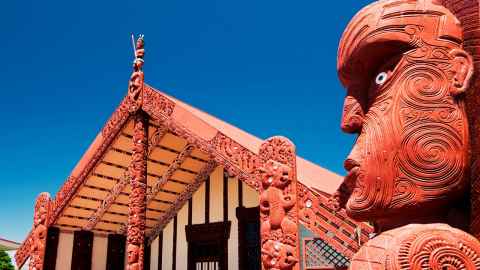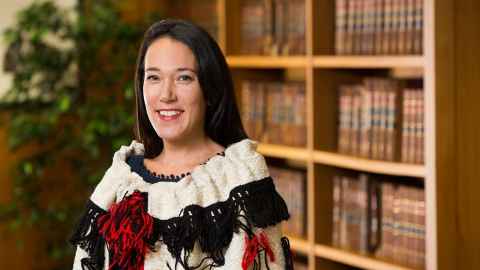The myth of sovereignty
2 November 2022
The idea of sovereignty underpins all our laws and institutions, and has been used to impose Crown authority over Māori. That’s despite the fact no one knows how it was legally acquired, writes Claire Charters.

Opinion: Something we don’t talk about much in mainstream public law circles is the basis of the Crown’s claim to sovereignty in this country. Perhaps it’s perceived to be irrelevant, because we have a “political reality” which simply operates as if there is full and indivisible sovereignty over these islands that we now all call home. But it’s a reality that is built on myth and assumption, not on the rule of law. And it demands our critical attention if we are to create just foundations for our future society.
In 1840, when Te Tiriti o Waitangi was signed, sovereignty could be legally acquired by cession, by conquest, or by discovery. From here developed a number of conflicting legal narratives to explain which of these best justified the Crown’s actions in this country. One of these narratives says that Māori lacked the legal capacity, as uncivilised peoples, to cede sovereignty.
The Crown thus acquired sovereignty under the doctrine of discovery. Modern revisions to the theory restore legal authority to Māori, reject the idea that Aotearoa was “discovered” by colonists, and variously suggest that Māori either did, or did not, cede sovereignty in Te Tiriti.
Other arguments made under British and international law say that, as Māori didn’t cede sovereignty under Te Tiriti, Māori authority remains.
Finally, there is the argument, cited by many today, that sovereignty was legally acquired by the Crown simply by the unilateral declaration of sovereignty, and then given effect under the act of state prerogative power.
In my view, this seems to be the most honest assessment, even though the claim to sovereignty under prerogative power was contrary to well-established British common law at the time. It might therefore be described as illegally legal.
The narratives and conclusions, of which there are many more, remain diverse and conflicting. Many of the orthodox theories have been convincingly shown to be implausible when tested against contemporaneous facts — they are shown to be what Matua Moana Jackson would call myth-takes.
As Professor Bruce Harris succinctly puts it, it remains “unclear how legal sovereignty passed.”
The myth that has endured is that the Crown does have sovereignty, and so there is little sustained attention to the problem in mainstream public law.
After all, legal myths are common. They can sometimes be a necessary part of retaining the public’s confidence in, and adherence to, the law. However, legal myths that perpetuate fundamental injustice should be exposed and dispelled, and the injustice remedied.
This is the situation we’re confronted with in Aotearoa New Zealand.
If we turn to how tikanga Māori addresses the question of sovereignty, then it becomes clear that we’re allowing our myth-making to perpetuate injustice.
In texts by Māori experts, in Waitangi Tribunal submissions, hearings and reports, especially in Wai 1040, there is an uncontested conclusion that the Crown did not, and could not, acquire sovereignty under tikanga Māori.
Moana Jackson concludes: So what Māori did . . . was grant to the Crown the right of kāwanatanga over the Crown’s own people . . . The Crown could then exercise its kāwanatanga over all European settlers, but the authority to control and exercise power over Māori stayed where it had always been, with the iwi.
Each legal system — Māori, British colonial law and international law — has its own narratives about the sovereignty question. But there is no obvious legal determination of which system or narrative should prevail.
So, it is power — not law — that has resolved the question of sovereignty in our country.

We have sovereignty claimed under prerogative, which the courts uphold irrespective of its legality. As Moana Jackson writes, English law that developed to implement colonisation was the “deliberate construction of a legal artifice taking away lands, lives, resources and power.”
I argue that the underlying conflict and implausibility of the claim to sovereignty mean the premises of Aotearoa’s constitution are unstable. Legal myth remains the basis for New Zealand’s constitutional structure.
This matters because it illuminates the type of thinking needed to post-facto legitimate and legalise Aotearoa New Zealand’s constitution.
If we are to take Māori retention of tino rangatiratanga seriously, take our international obligations seriously and attach importance to the western liberal thinking on the need for consent, it becomes clear that constitutional reform in Aotearoa requires something transformative.
It requires more than a tweaking of the Westminster legal system, more than a Treaty claims settlement process, more than a Waitangi Tribunal, and more than incremental judicial incorporation of tikanga Māori — because all of these structures are premised on the mythical legal claim by the Crown to sovereignty.
Most importantly, it’s not enough to adopt a western-style, higher-law written constitution. Aotearoa New Zealand needs a constitution that can reconcile the coming together of two peoples and two legal orders and that can justifiably claim to regulate multicultural and multiethnic contemporary New Zealand.
Without transformative change, New Zealand’s constitution will continue to perpetuate the fundamental injustice of colonial subjugation of Māori and the illegal imposition of authority by the Crown, contrary to the rule of law. It will remain unstable. Our attachment to the state and our adherence to law could falter.
So what might transformative constitutional design look like?
The Matike Mai report, prepared over years and based on nearly 250 hui with our peoples, could be the starting point.
Some elements might include clear spheres for Māori jurisdictional autonomy, where we can practise our tino rangatiratanga, mana motuhake, and self-determination. This might include exclusive authority over some spaces such as marae or other distinctively Māori areas including territories currently in the conservation estate, such as rivers and mountains.
It might also include authority over some issues such as Māori cultural property, te reo Māori, and areas such as health and criminal justice where there are obvious social and economic disparities.
It might also include greater inclusion of Māori and tikanga in state governance, as well as the enforceability of Te Tiriti o Waitangi over legislation and executive authority.
My instinct is that the intersection between tikanga Māori and state law should be determined, in the main, by agreement between rangatira and the Crown, supported but not constrained by developing common law.
Despite decisions like Ellis, the courts are not the only place where these issues ought to be addressed nor necessarily the best space.
We should go beyond anglo-western legal systems in thinking about constitutional design to places where there is ongoing and dynamic attention to decolonising legal systems and constitutions.
We can, and should, also think about constitutional developments in other corners of the world. Constitutional transformation in Chile, the Saami parliaments in Norway, Sweden and Finland. I am always surprised that we don’t look more to the Pacific and, especially, examples of recognition of customary Indigenous laws there. Traditional authorities are recognised in the South African constitution. Greenland is moving towards independence from Denmark.
This is not to say that our circumstances today, or our history, require similar constitutional designs — we should be a proudly independent country with our own solutions to our own issues. But they certainly provide inspiration for more creative and just foundations for contemporary New Zealand today.
Aotearoa New Zealand needs to confront the injustices of our past and the ongoing impacts today. That starts with confronting the myth of sovereignty.
Dr Claire Charters (Ngāti Whakaue, Tūwharetoa, Ngā Puhi, Tainui) is an Associate Professor of Law at the University of Auckland, specialising in Indigenous Peoples’ rights. She is hosting the Constitutional Korero at the University of Auckland this November.
This article reflects the views of the author, and not necessarily the University of Auckland Wapapa Taumata Rau.
The article was first published on e-tangata, on 31 October, 2022.
Media contact
Sophie Boladeras I Media adviser
Mob 022 4600 388
Email sophie.boladeras@auckland.ac.nz